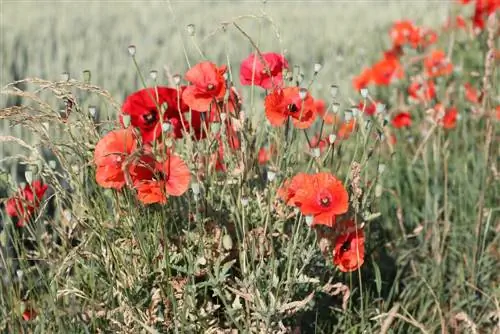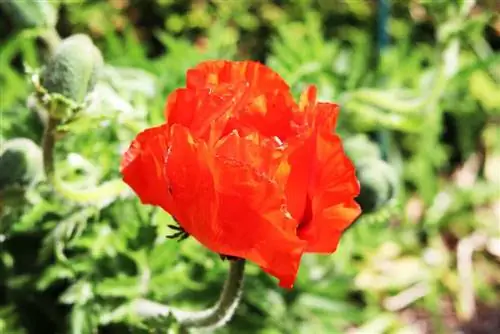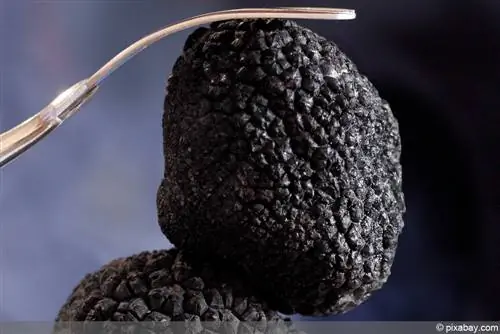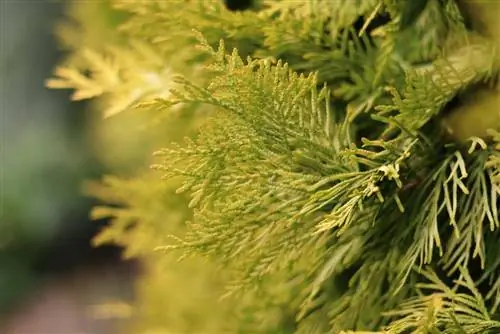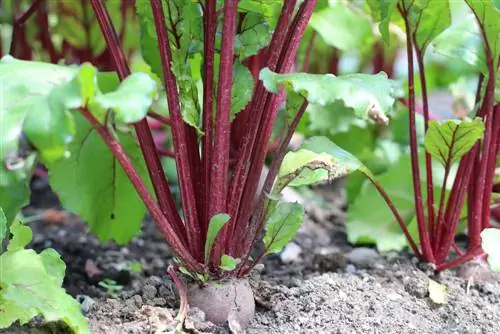- Author admin [email protected].
- Public 2023-12-17 03:39.
- Last modified 2025-06-01 06:48.
Opium poppy can be bought everywhere in the form of seeds as food and also as seeds. Since the opium poppy, also known as the garden poppy, has an intoxicating effect and opium can be obtained from the juice, the cultivation of the Papaver somniferum in Germany falls under the narcotics law.
Legal situation
After poppy cultivation was included in the German Narcotics Act, the commercial cultivation of opium poppies came to an abrupt end. Before the Second World War - and in the GDR even up to the time of reunification - this was widespread here. Today the cultivation of opium poppies is banned in Germany. Anyone who wants to cultivate it needs a permit. Even if it is only intended to grow as an ornamental plant in the garden! Anyone who cultivates the opium poppy without this permit is violating the Narcotics Act (BtMG). Such a violation can be punished with a hefty fine and/or up to five years in prison. Even private cultivation on small areas or even individual plants is subject to approval requirements. Opiates may contain the following poppy seeds:
- Papaver somniverum (opium poppy)
- Papaver bracteatum (Armenian poppy, medicinal poppy)
- Papaver paeoniflorum (variety of the opium poppy, actually Papaver somniferum var. paeoniflorum)
Unauthorized planting of these poppy species is strictly prohibited. In exceptional cases, however, cultivation can be permitted by the Federal Opium Authority.
Apply for approval
Not only agricultural businesses, but also private individuals can obtain a permit for the cultivation of Papaver somniferum at
Federal Institute for Drugs and Medical Devices - Federal Opium Office - apply in Bonn.
To do this, an application for a permit in accordance with Section 3 of the Narcotics Act (BtMG) for the cultivation of Papaver somniferum (opium poppy) must be filled out and sent to the Federal Institute. You need:
- completed application
- readable copy of the ID card (copied on both sides)
- a land map, plot plan or other official document identifying the acreage
A permit for private individuals is issued for a maximum cultivation area of 10 m² and a maximum period of three years and costs 75 euros.
Appearance
The opium poppy is a magnificent annual flowering plant that differs significantly from the wild poppy (Papaver rhoeas) or the Turkish poppy (Papaver orientale), which are cultivated as ornamental plants, both of which do not contain morphine.
- pink to purple flowers with a dark spot on the base
- also in white flower color
- Leaves are not green, but gray-green or blue-gray in color
- the leaves are not as pinnate as those of the corn poppy and Turkish poppy
- rather flat, large leaves that are a little reminiscent of cabbage
- high growth habit (50 to 150 cm)
- large spherical seed capsule in gray-green
Tip:
There are also some poppy plants that are similar to the opium poppy, but only contain small amounts of the alkaloids. Some are visually difficult for the layperson to distinguish from opium poppies. So please be careful when purchasing.
Poisons/Intoxicants
The opium poppy contains around 40 different alkaloids, which are mainly found in high concentrations in the milky juice. These include codeine, morphine and papaverine. By scratching the seed capsules, the milky juice comes out, which is then used to produce various intoxicants such as morphine, opium and heroin.
Poisonings
Poisoning often occurs when handling the opium poppy due to ignorance or a lack of caution. Escaping milky juice contains the highest concentrations of intoxicants and toxins. These enter the body when they come into contact with the skin and can have an effect on the central nervous system. Breathing in particular is severely affected by the various ingredients. Symptoms are:
- Nausea
- Vomiting
- Redness of the face
- constricted pupils
- Daziness
- at higher concentrations the patient falls into an anesthesia-like sleep
- Heart activity and breathing decrease
- Skin areas turn blue
- Death from respiratory paralysis
- The lethal dose is 3 g of opium (equivalent to 0.2 g of morphine)
Active ingredient content
Various properties, such as the alkaloid content, are hereditary in opium poppies. However, the morphine levels are not naturally high, but rather the result of human breeding. However, depending on the location and weather conditions, the levels in the plants vary greatly.
Opium poppy varieties
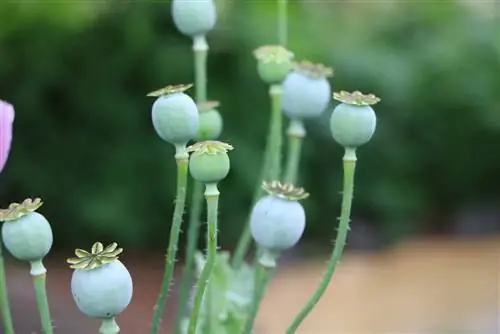
The opium poppy includes three subspecies that differ slightly in their alkaloid content. These include:
- Papaver somniferum subsp. somniferum
- Papaver somniferum subsp. setigerum (also called Papaver setigerum)
- Papaver somniferum subsp. songarium
There are commercially available varieties that have been bred for commercial alkaloid production, those with a low morphine content, which can theoretically be grown without a permit, and those species for which the content is not further declared and which are available as freely available seeds for the hobby gardener. Since the trade in opium poppy seeds is not subject to the Narcotics Act, buying and selling is legal.
Breeds
Opium poppy varieties are divided into early-flowering varieties (winter poppies) and late-flowering varieties (summer poppies). While the winter poppy ripens in June, the summer poppy needs about three weeks longer. In addition to many varieties containing morphine, there are also a few varieties that contain very little of this substance.
Approved in the EU:
1. Varieties with high morphine contents (not suitable for private cultivation!)
- MOTOR: new variety with high active ingredient content
- OZ: high-yielding variety
- ZENO PLUS: most common variety of winter poppy (certified seeds)
- ZENO2002: older variety of winter poppy (certified)
- ZETA: summer poppy variety with high or low morphine content for different climate areas (with certificate)
2. Varieties with very low alkaloid contents
- 'Mieszko' (low-morphine variety approved by the Federal Opium Office)
- ‘ZENO Morphex’: first bred winter poppy variety (2007) with certification (less than 200 mg/kg in the dried capsule)
The Federal Opium Agency has now withdrawn the approval for the 'Przemko' variety, which was granted in 1996. In addition to Papaver somniferum, the varieties Papaver bracteatum and Papaver paeoniflorum also contain opiates and should not be grown without permission as a precaution.
Instructions for sowing and care
The perennial opium poppy is considered easy to care for and is easy to cultivate in our latitudes.
Location
Papaver somniferum can be easily cultivated in our climatic conditions - even in low mountain areas. The annual plant needs a lot of sunlight, but not too much heat. This tall-growing poppy species harmonizes particularly well with neighbors such as the sedum, daisies, goldenrod or delphinium.
Floor
Opium poppy prefers well-drained gravel and sandy soils. Ideally, the garden soil is also nutrient-rich. If the soil requirements are well met, the gardener can look forward to a particularly magnificent flower.
- well permeable to water
- sandy or gravelly
- profound
- nutrient-rich
- pH value: neutral (between 6, 5 and 8)
Preparing the soil
Since the opium poppy likes sandy-loamy soil conditions and appreciates a high nutrient content, most garden soils need to be prepared a little to ensure optimal growth conditions.
- Dig up the bed
- Improve soil with compost
- possibly make it permeable to water with sand
- break up coarse chunks of earth with a rake
- Let the bed rest for a few days
Sowing
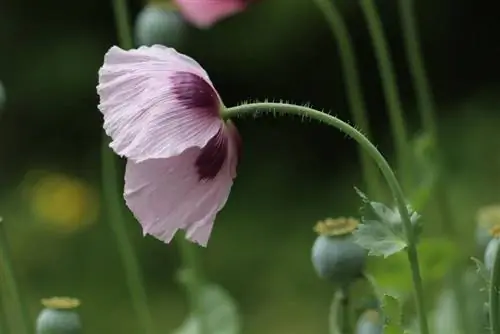
Once you have obtained permission for cultivation, you can sow the opium poppy seeds directly outdoors in spring. When it comes to cultivation, this poppy hardly differs from many other poppy species such as corn poppy or Turkish poppy. To avoid having to grow too many poppy plants in a small space, it is recommended to mix the seeds with a handful of fine sand before sowing.
- Time: between the end of March and the beginning of April
- directly outdoors possible
- Spread seeds widely
- Row spacing: 50 - 80 cm
- do not or only cover thinly with sand (protection from birds)
- Poppy is a light germinator
- pour carefully
- Germination time: 8 to 10 days (maximum 21 days)
- Keep substrate slightly moist at all times
After a germination period of just two weeks, the first leaves appear on the still young plant.
Tip:
You can also plant the seeds in autumn (September). If you let the dead plants stand and the seed capsules mature, they will sow themselves.
Pouring
Like all seeds, the seeds of Papaver somniferum require sufficient water until they germinate. To avoid washing away the seeds, you should either use a very fine watering attachment for the watering can or just spray the soil with the garden hose.
Once germination has taken place, the opium poppy is quite frugal when it comes to its water balance. The sun-hungry plant survives even long dry periods without any problems. Nevertheless, it should be watered occasionally.
Fertilize
If you have already improved the garden soil with compost or green manure before sowing, no additional nutrients are necessary during the entire growth phase of the opium poppy. Otherwise, a little long-term complete fertilizer will help. At the beginning of the growth phase, the opium poppy needs a phosphorus-rich fertilizer, and later a fertilizer with a high nitrogen content. However, use the fertilizer sparingly, because the poppy tends to shoot up when there are very high amounts of nitrogen in the soil and its pretty flower stalks break off as soon as it is windy or raining.
Cutting
The Papaver is also uncomplicated when it comes to grooming. It is limited to removing wilted plant parts (wear gloves). Since this mainly affects the flowers, you don't have to cut at all if you want to harvest the seeds or sow them yourself. As soon as the plant has completely dried out in late summer, you can cut it off close to the ground after the seed capsules have ripened.
Wintering
Opium poppy is one of the annual plants that die in autumn at the latest and the next generation of plants is created by scattering the seeds. For this reason, no maintenance measures are necessary before winter.
Beautiful ornamental varieties as an alternative
Instead of the delicate opium poppy, gardeners who only want to grow the plants for ornamental value should use equally beautiful but uncritical varieties. These are available in many different colors with double or unfilled flowers.
Turkish poppy (Papaver orientale)
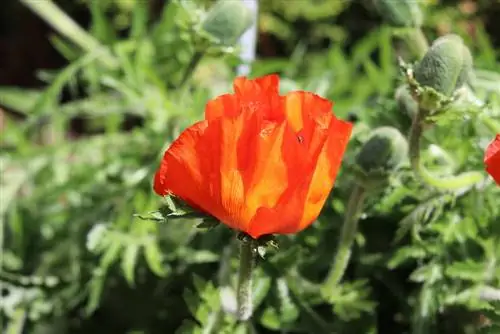
The Turkish poppy is a perennial herb. It produces bright red flowers with slightly wrinkled petals between May and June. As an ornamental plant it can also be found with white, orange, yellowish or salmon-colored flowers.
- also called oriental poppy or Turkish poppy
- mostly as hybrids, perennial
- Growth height: 40 to 90 cm
- Flowering period: May to June
- white, pink or red flowers, unfilled
- Occurrence: Asia
- ‘Aladin’: strong red flower
- 'Brilliant': older, widespread variety with orange-red flowers
- ‘Helen Elisabeth’: elegant, salmon-colored flowers
- ‘Princ. Victoria Louise': old pink flower with wine-red background
- ‘Royal Wedding’: white flower with red-black background, speckled in contrast
- 'Türkenlouis': bright red flowers, fringed on the edge
Iceland poppy (Papaver nudicaule)
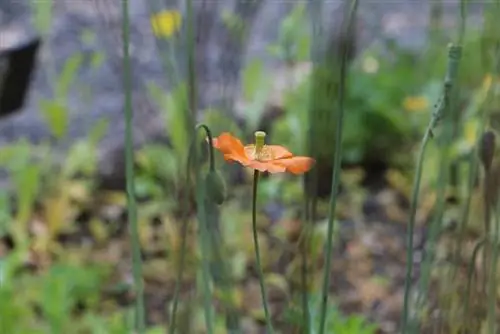
The Icelandic poppy with its flowers up to 15 centimeters in size is considered particularly robust and is also suitable for cooler regions. The various cultivated forms include both annual and biennial plants. In contrast to almost all other poppy species, the Icelandic poppy likes it to be a little cooler.
- Growth height: 50 to 60 cm
- Flowering period: June to September
- white, yellow, scarlet or salmon-colored flowers, unfilled
- Occurrence: Asia, Eastern Europe
- beautiful varieties: 'Yellow Wonder', 'Cardinal', 'Matador', 'Pulchinella'
- Special feature: cold germinator (must be sown in autumn)
Alpine poppy (Papaver alpinum)
A low-growing variety of poppy that only reaches a height of 20 cm is the Alpine poppy. Because of its size, it needs completely different neighbors than, for example, the emerging Turkish poppy. At first glance, the untrained eye hardly recognizes the plant with its exotic flowers as a type of poppy.
- Growth height: 5 to 20 cm
- Flowering period: May to August
- yellow, orange or white flowers, unfilled
- Occurrence: Low mountain ranges in Europe
- prefers calcareous soils
Common poppy (Papaver rhoeas)
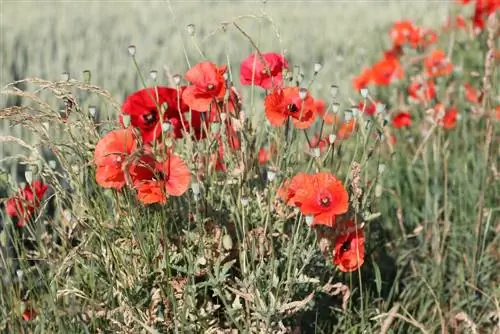
Wild poppy species that adorns railway embankments and roadsides with its bright red flowers.
- Growth height: 20 to 90 cm
- annual
- Flowering period: May to July
- bright red, unfilled flower with black base
- Eurasia occurrence
- does not tolerate full sun
A ban that no one adheres to?
In fact, the opium poppy can not only be found in seed bags everywhere (sale of seeds is legal, but cultivation is not), but also in many ornamental gardens nationwide. The illegal drug plant can often be found growing wild on the banks of the B altic Sea or on highway embankments. Some florists sell freshly cut capsules as decoration for bouquets or use them dried in arrangements. Apparently hardly anyone is aware of how strictly the opium poppy ban is punished. However, you should be aware of this: Even ignorance does not protect you from punishment.
Conclusion
If you happen to already have an opium poppy plant in your garden, you don't have to panic, because after all, Papaver somniferum also grows wild here. No agency has the time to hunt down every single Papaver somniferum. However, you should not dare to experiment with home-made opium or other intoxicants made from the sap of the plant. Depending on the variety and location, the ingredients contained vary greatly - and even small amounts of morphine can be fatal.


